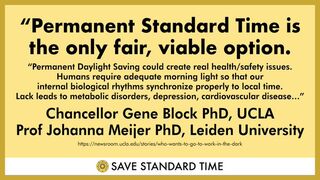Sleep
How Should We Fix the Daylight Savings Disruption?
Permanent Standard Time is most in sync with the planet and human biology.
Posted March 23, 2021 Reviewed by Matt Huston

We have now switched back to Daylight Savings Time once again having spent just 133 days synchronized to Standard Time. Standard Time, where it is noon anywhere in the world when the sun is directly overhead, is the clock-keeping measure that most closely accords with human biology and the circadian clock housed in our brain.
The heated debate over which of the two formats is preferable concerns far more than “a mere hour.”
The Downside of Daylight Savings
Past research suggests the new adjustment may coincide with an increase in emergency-room visits, heart attacks, moodiness, and other negative developments. In an earlier column I outlined some of the risks associated with switching the clock back and forth twice a year.
The spring season time-change appears to affect some people more than others. Night owls who typically stay up late and prefer to sleep in may have it the roughest, while even morning larks can be grumpy, listless, and generally out of kilter in the week or two after pushing the clock forward. Many people feel the urge to nap or have a hard time concentrating. “Spring forward” fights against our natural circadian rhythm, making it particularly annoying for those who chronically don’t give themselves enough sleep.
Politicians get it wrong
It is a quirk of United States law that the debate over which time system is “better” cannot be settled except by an act of Congress! And when politicians meddle, they can make a muddle of things. Such is the case, unfortunately, with the misnamed “Sunshine Protection Act” proposed by Senator Marco Rubio (R–Fla) and seven Senate co-sponsors (three Democrats and four Republicans). The idea is seriously mistaken even if well-intentioned. How so?

First, turning the clock forward does not increase the total hours of daylight at all: it merely shifts it from morning to evening. The Earth tilts between 22.1 and 24.5 degrees on its axis, periodically shortening the time that the sun hovers above the horizon. This causes naturally shorter days during the winter months.
The bigger problem than the cyclical variation in day length is the havoc that changing mechanical clocks wreaks on the timekeeper in our brain. This timekeeper synchronizes itself each day to the changing length of light and dark periods, giving us our circadian rhythm (circadian = “approximately one day”).
On Twitter, Senator Rubio extols us to #LockTheClock and laments “the senseless twice a year ‘time change.’ We need to pass my bill to make daylight savings permanent. More daylight in the evenings results in fewer car accidents & robberies. And it allows kids to play outside longer.”
But as I outlined earlier, making Daylight Savings permanent merely shifts the time—according to the clock—of sunrise and sunset. From early March to November 1 the sun will rise and set an hour later than we are accustomed to during the winter, while the body’s inherent timekeeper hews to the different time zone dictated by the sunrise determined by the rotation of the planet. While 4:30 sunsets would be banished, winter mornings would be noticeably darker and colder.
We tried year-round Daylight Savings before
The United States actually tried year–round Daylight Savings Time for two years during the 1970s energy crisis (from January 1974 to October 1975). Parents and teachers objected to the safety risks of sending kids to school in the dark. Under a permanent Daylight schedule, sunrise wouldn’t take place in my hometown of Washington, D.C. until after 8 a.m. from Thanksgiving to Valentine’s Day. For cities at the western edge of their time zones, such as Detroit or Indianapolis, the winter sun wouldn’t come up until after 9 a.m.
Body and brain have a hard enough task keeping track of three different biological measures of time: (1) the 24-hour sun clock that monitors, through special cells in the retina, the proportion of light and dark we receive each day; (2) the physiological cycles that govern everything from urine output and potassium excretion to appetite, hormone secretion, and the ability to focus; (3) and the cultural schedules of work, school, recreation, and social interaction.
The American Academy of Sleep Medicine recommends the abolishment of twice-yearly seasonal time changes “in favor of a fixed, national, year-round Standard Time.” Standard Time is also endorsed by the American Academy of Neurology, the National Safety Council, and authorities who study chronobiology.
Jay Pea, founder of Save Standard Time, wants to correct Senator Rubio and company. “Permanent #StandardTime is best for health, safety, kids, and workers,” he says.
Please email questions and comments via the Author Profile link below.
References
Daylight saving time: an American Academy of Sleep Medicine position statement.
Ditching the daylight saving time change for better sleep, health and safety. American Academy of Sleep Medicine.
Reasons Why Daylight Savings Is Bad for You
Why Many Hate the Switch Back to Daylight Savings Time
Getting Morning Light After Turning Back the Clock is Crucial.




